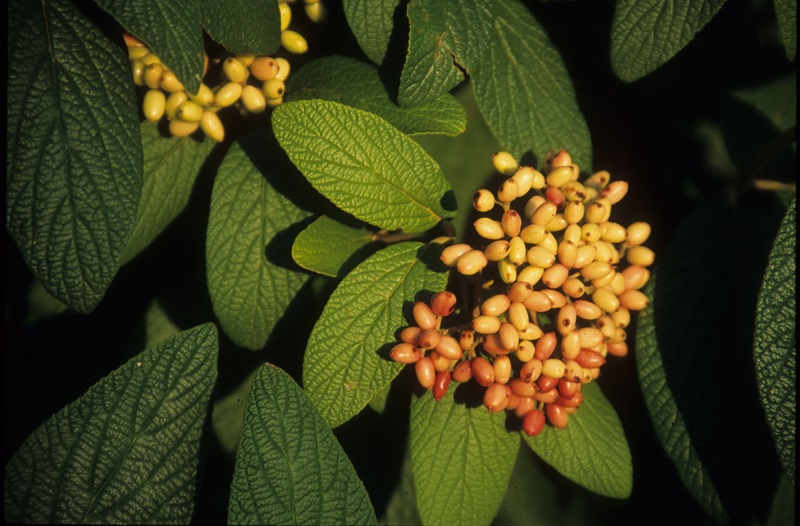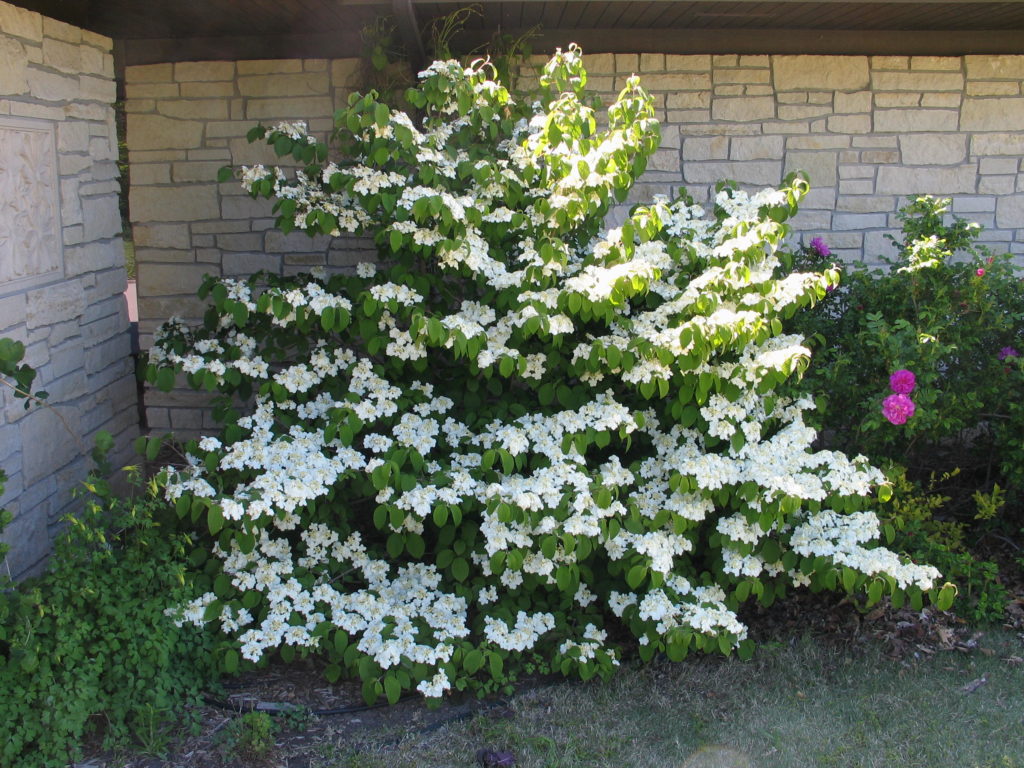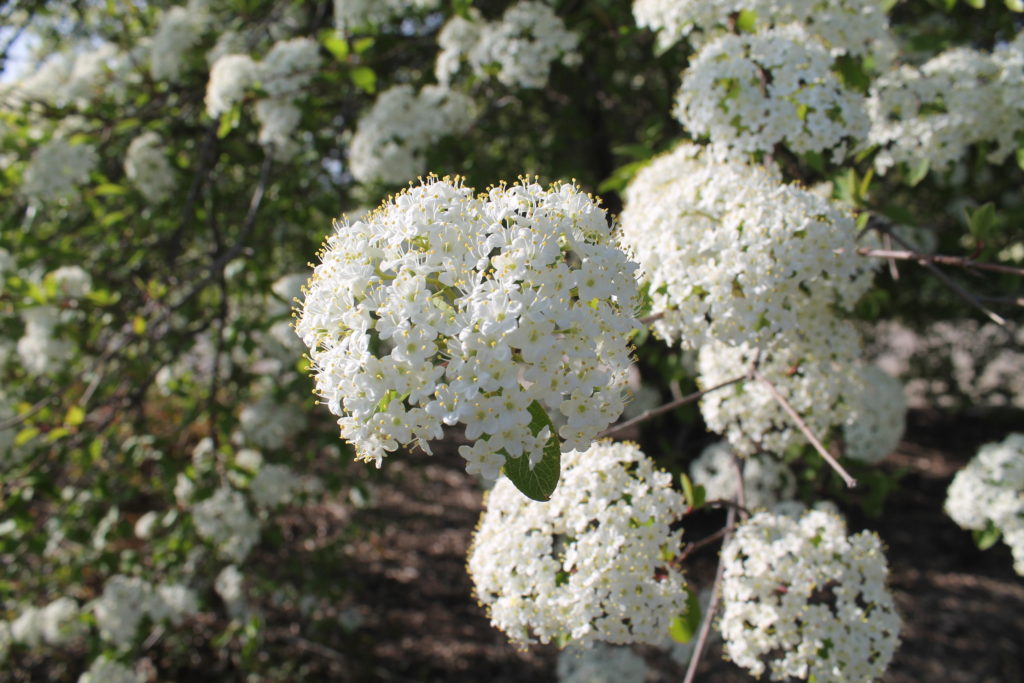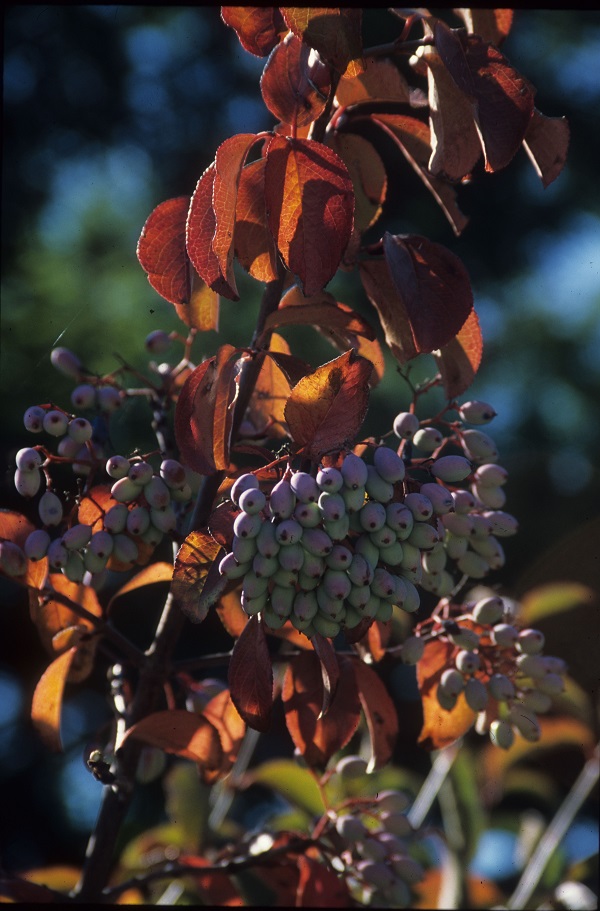In addition to our interest in native trees, shrubs, wildflowers and grasses, one of the goals of the Arboretum is to grow plants which, while not native, are adapted to the rigors of the central Kansas climate. We are especially interested in displaying plants that are not widely grown in the area, but that show excellent hardiness and landscape potential.
The viburnums are a perfect example. While not as widely known as forsythia and lilac, these shrubs deserve much more use in our landscapes. Not only do they offer year-around show of ornamental attributes, such as abundant floral displays, fragrance, outstanding fruiting characteristics, and fall color, they are also hardy and can serve a number of important uses in the landscape.
The Arboretum collection currently features a number of different viburnums, each displaying unique characteristics and qualities. Most of the viburnums can be seen along the east border of the Arboretum, just south of the parking lot. A planting on the north bank of the Amphitheater features several additional kinds along with some newer varieties in the Pinetum.

Fragrant snowball viburnum – Viburnum x carlcephalum https://en.wikipedia.org/wiki/Viburnum_%C3%97_carlcephalum
The three most fragrant viburnums in the Arboretum’s collection are the Koreanspice Viburnum (Viburnum carlesii), fragrant viburnum (V. x carlcephalum), and Judd viburnum (V. x juddii). These three are somewhat similar in appearance because the latter two are hybrids involving a cross between the Koreanspice and another viburnum. They are medium size shrubs (6-10 feet tall). However, our collection also includes a dwarf form of the Koreanspice. All produce clusters of fragrant white flowers in April into May followed by inconspicuous black fruits.
Another fragrant type in the Arboretum is Burkwood Viburnum (Viburnum x burkwoodii). This semi-evergreen grows 8-10 feet fall and produces a white snowball-like flower cluster in April. The fragrance in somewhat sharper, almost spicy.
Like the burkwood viburnum, Willowwood viburnum (Viburnum x rhytidophylloides ‘Willowwood’) is semi-evergreen, retaining its furrowed, leathery leaves throughout much of the winter. This 7-10 foot shrub blooms in April and often to a lesser extent again in October. The blue-black fruits are attractive and can be quite abundant. Another form that is really attractive is ‘Alleghany’ which has tough, leathery leaves, attractive white flowers and abundant bunches of reddish-purple fruit.
The Wayfaringtree viburnum (Viburnum lantana) grows as a large shrub or small tree (12-15 feet). While not fragrant to any degree, it produces an outstanding floral display in May, followed by red-black fruit in late summer that persists into fall. Fall color is often red, although it is not consistent.
Another large shrub is the Wentworth cultivar of the American cranberrybush (Viburnum trilobum ‘Wentworth’). The Wentworth viburnum was selected for its large, edible fruits, which progress in color from yellow to red to bright red and persist throughout winter. Birds seek out the fruits from fall through winter. I have often thought that this shrub was at is best on bright winter days with the fruit highlighted against a snowy background. It is also attractive in May with its show of white, flat-topped flower clusters. A dwarf form of the American cranberrybush is found on the north bank of the Amphitheater.
Tucked up under the northeast corner of the Visitor Center is a viburnum that is very attractive. The Doublefile viburnum (Viburnum plicatum forma tomentosa ‘Shasta’) is stunning in bloom as the flowers are held horizontally above the branches. It has insignificant fruit, but the spring flower show makes up for it.
The last two species in the Arboretum collection are the Blackhaw (Viburnum prunifolium) and southern or rusty blackhaw (V. rufidulum). These two species are native to Kansas and distinct from each other. Blackhaw viburnum is a large shrub or small tree that has smaller leaves and brighter fall color with oranges, yellows and reds. The dense flower clusters develop into purplish-black fruit that the birds love.
Rusty blackhaw is not widely available in the nursery trade at this time, but extremely adaptable and hardy. The glossy dark green leaves turn a nice burgundy-purple in the fall. Large, white, flat-topped clusters of flowers appear in early spring and later produce bunches of fruit that change from red to purple through the fall. Again, many types of birds cherish the nutritious fruit. These two native viburnums are my personal favorite, because they are the most adapted to our Kansas landscapes and have so many wonderful qualities.
Any way you look at them, the viburnums are a versatile and highly ornamental group of plants that deserve a greater use in the landscape. We will continue to integrate new species and varieties into our plantings as development of the Arboretum progresses.




